Indian Football Coaches Saksham Kakkar and Dipankur Sharma have in detail dissected ‘Build-Up’. Part 1 covered: Origins of the build up; Definition of a build up; Why do teams build up?
This piece will cover:
- Principles
- Patterns
Principles:
As a fan trying to understand build-up play or a coach wanting to implement this into their team’s style of play, it is important to understand the basic principles that are fundamentally required for any team to progress with the ball, through the thirds. It is under the ambit of these principles that coaches can implement their own ideas and innovations to achieve their goal of successfully progressing play from the defensive to the attacking third.
1)Width and Depth (Occupation of Space)
To start, we breakdown the pitch into five zones vertically (two wide, two half spaces, and the central) and 3 thirds horizontally (defensive, midfield and attacking). When a team is looking to build-up play, it is important that they occupy all the spaces either positionally or by arrival (dynamic).
Advantage: By positioning players in all five zones (to provide width) and three thirds (depth), the team ensures that they have multiple passing options available at different angles (triangulations). This in turn commits more defenders from the opposition, to the press, as they have more passing options to block.
In a situation where a team does not follow this principle, it becomes easy for the defending team to make the play predictable and press the attackers to win the ball.
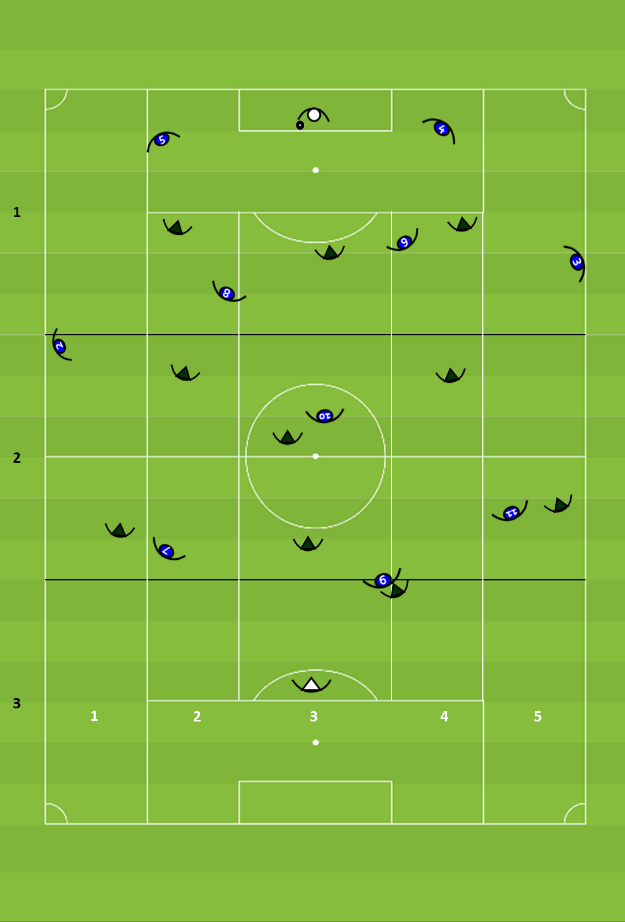
Sub-principles involved:
a. Connecting attackers: Teammates position themselves in a way that the on-ball player can find them with his pass. Distance between the players varies according to the game idea. Lesser distance leads to quick passes and combinations while more distance can allow the player more time on the ball.
b. Triangulation: The off-ball attackers need to create open passing lines (minimum two options) for the on-ball player to reduce the predictability of the attack. The more passing options available for the player the more difficult it is for the defenders to press.
c. Spatial Awareness: Players need to be aware where the space is available on the pitch. Depending on the game idea, this space can be occupied positionally or by arrival.
2) Positioning :
As a continuation of the previous point, the players need to position themselves in a way that they can gather information on the pitch (space, opponents, teammates, etc.) to progress the ball forward. According to the game idea, the positioning of the players changes in order to achieve the desired objective.
Advantage: With the aim of the build-up being, to progress the ball to the opposition half with an advantage, the attacking team positions it’s players in a way that they can create the necessary superiority to break the opponent’s defensive lines. This includes dynamic occupation of favourable spaces on the pitch and making proactive and reactive movements according to the opponent’s press.
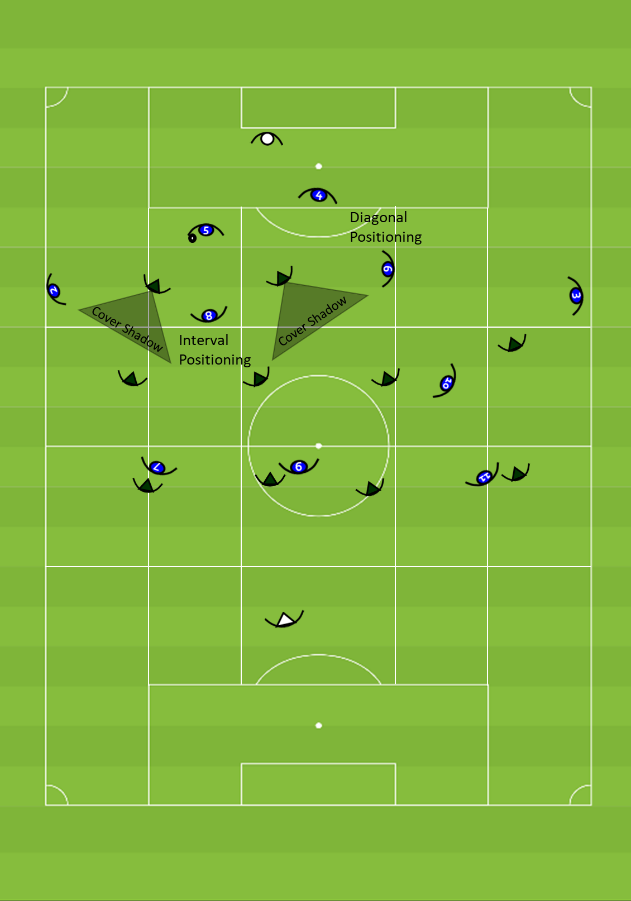
Sub-principles involved:
a. Positioning on different lines: The supporting players should position themselves diagonally to the on-ball player, on different lines (both vertically and horizontally) and provide an option for the team (either with the first pass or the second).
b. Gather Maximum Information: Receiving player to have an open body shape and be aware of his teammates and opponents around him before receiving. Based on this information, he may receive the ball with the back foot (space to move into) or front foot (defender close to the player).
c. Diagonal Support: By positioning yourself in relation to the defender (on the same line as his shoulder) the player creates an opportunity to break that line of press with his first touch. Body shape of the receiver and first touch essential for this to be completed successfully.
d. Interval positioning: The attacker can also position himself between two lines of defence (midfield and forward or defensive and midfield) or in the space between two opponents. This ensures that the player occupies multiple opponents at the same time which may lead to the defenders compressing in that area of the pitch (leaving more space for the attacking team elsewhere) or a through ball being played to this player between the lines.
e. Cover Shadow: This is the space that is left behind the pressing defender. Supporting players need to ensure that they move out of the cover shadow of the pressing player to provide an option to the on-ball player.
f. Counter Pressing: While progressing play forward, the team needs to accept that at times, the build-up would not be successfully completed. For this reason, they need to position players behind the ball to counter press in a situation of ball loss.
3) Rotation:
To destabilise the opposition shape and create space for yourself or your teammates, the attackers can rotate positions with teammates on the same line (midfielders switching with each other) or on different lines (midfielder switching position with a centre back or fullback). The objective of this principle is to disorganise the opponent and create space to progress the attack.
Advantage: Players rotating their position forces the defenders to make a decision between following the attacker, which could create space for another player or to cover the space, in which case the attacking team has a free man during the build-up. Vacating your position (moving out of your area) can drag the defender out from that position as well, freeing up space for the on-ball player to play grounded second line passes.
Sub-principles involved:
a. Dynamic Movements: Players occupy space dynamically and change position according to ball, teammates, space and opponents.
b. Opposite Movements: Players use triggers from their teammates to make a run opposite to their teammate. The objective is to drag your defender with you while creating space for your teammate to exploit.
c. Check-in, check-out: Supporting players make movements with an objective to destabilize the defender and drag him away from favourable spaces which they or their teammates can use to progress play.
d. Third man run: One of the most effective ways to use a spatial advantage, third man run focuses on attracting defenders towards the ball before playing a pass into space for a teammate.
4) Superiorities:
As discussed earlier in the article, teams can create superiorities in the form of numerical, positional, qualitative, dynamic and socio effective. Creating a form or a combination of different superiorities is the basis on which teams progresses their attack. Teams can also use inferiorities to create superiorities e.g. creating an under-load situation (numerical) to progress with a dynamic superiority. The team building-up has to recognise on the pitch, or pre-determine what kind of superiorities they wish to create and make particular actions to execute the same.
Advantage: Creating superiorities ensures that the team builds play with an advantage and the chances of losing the ball is reduced. Creating superiorities can also force the opposition to commit more defenders into that part of the pitch, thereby leaving space in other parts.
Sub-principles involved:-
a. Combination Play: This can be done in the form of a ‘one-two’ pass, a ‘wall pass’ or a ‘lay off’. Players pass the ball and move dynamically to occupy new spaces on the pitch.
b. Third man pass: Players connecting to pass the ball to a teammate in an advantageous position. Usually used to shift the opponents and pass the ball to a player with more time, space or a better position.
c. Driven Pass: While playing a long pass, there is an advantage if it is played with pace (driven) when possible over a lobbed pass. Otherwise, the defending team may be able to shift and close down the space. In a situation where the player would need time to reach the target space, the team can prioritize a lobbed pass.
d. Switch Play: The objective of this sub principle is to shift the opposition onto one side of the pitch to create space on the other side. Teams can create spatial, numerical and/or qualitative superiorities by switching the attack.
e. Recognising bonds between teammates: As players spend a lot of time on and off the pitch together, some develop a higher understanding of each other’s movements. This can utilized by the team while building up their attack (eg. Messi and Alves/Alba)
f. Continuation of run: After passing the players should continue their run to be further involved in the attacking play. This can help the team in creating overloads and disbalance the opposition shape. This sub-principle, although important, is dependent on the position of the player (on the pitch), role in the team and position of teammates and opponents around. At times the player may need to hold his position to protect space behind.
g. Quality of Pass: This includes the weight of the pass, played to the correct foot of the teammate (according to the press).
5) Creating Space:
An attacker in space, has the time to pick multiple options (switch play, dribble, through ball, etc.) with the ball at his feet. It makes the next move of the team unpredictable for the opponents. That is why the principle of creating space is pivotal to a team’s build up play. The attacking team can organise their build up play to either create space between the opposition lines or behind their defensive line.
Advantage: Creating space between the opposition lines gives the on-ball player more time to pick out his next option. The team can use this opportunity to, change the direction of the attack (isolate the far side opponent with switch play), play a through ball/long ball to a player making a run behind the opponents defensive line, etc.
Sub-principles involved:-
a. Dismarking: The supporting player needs to time his movements in a way that he can move away from the defender to create space (for himself or his teammates) when there is opportunity to receive a pass. This is usually achieved by performing a check-in check-out movement by the supporting player.
b. Dynamic Occupation of Space: Players position themselves on the pitch in a way that, certain spaces are left free to be occupied ‘dynamically’, when the pass is played into that space. Players receive the pass by arriving into that space instead of starting from there.
c. Combination play, Third man pass and third man run are some of the other sub-principles used by teams to create space between or behind the defensive line of the opponents.
6) Fixing:
Fixing, as the term suggests, means to, ensure that the opponent (or opponents) are stuck in that position and do not shift to cover any other space or attacker. To facilitate the build-up, the attacking team can either fix the opponent to one side of the pitch, to switch the ball and take advantage of the spatial and/or numerical superiority of the other side. Or use it at a more micro level where an attacker fixes an individual opponent by dribbling towards him and creating a superiority (numerical, qualitative etc.) around him to progress.
Advantage: The objective behind fixing opponents is to create and/or maintain superiorities for the team. The action ensures that the opponents are stuck to their position or their side of the pitch and the attackers can progress forward with an advantage.
Sub-principles involved:
a. Control the Pace: Player to fix an opponent by slowing down or pausing the attack. This can lead to a defender pressing the player, leaving space behind for the attacking team to exploit. This action also buys time for the teammates to occupy favourable spaces on the pitch.
b. Bounce Pass: A team uses bounce passes to attract opponents towards them (bait) by playing multiple passes between teammates on the same line. When the defenders try to press, it creates space behind them for the attackers to exploit.
c. Flatten the Press: The objective of this sub-principle is to create space between the lines for the attacking team. The team can use bounce passes or a dribble to attract multiple defenders towards them which creates the space between the lines for their teammates to exploit.
d. Fixing “Off the ball”: Supporting attackers can fix defenders by making runs which are visible to them. The objective of this action can be to drag them away from a particular space or teammate, or to destabilise their defensive shape.
7) Progress with an advantage:
This last principle is a culmination of those before it and talks about the decision the team and individual players have to make about, progressing the ball forward. The players need to identify individual situations on the pitch, recognise if they can create a superiority over the opposition players and then progress the play forward. In a situation where no superiority is visible, the team can recycle the ball in an attempt to destabilize the opponent and create an advantage.
Advantage: A good build-up is one in which the team enters the opponents half with a superiority. This increases the chances of the attack leading to a goal-scoring opportunity.
Sub-principles involved:-
a. Ball Circulation: Players circulate the ball in an attempt to destabilize the opposition shape and open spaces to attack.
b. Creating Multiple Options: Supporting players need to be positioned in all directions around the on-ball player. Each option provides a different advantage, eg. Passing back can help push the opposition further up the field thereby creating space between the lines.
c. Emergency exit: In a situation where the team is unable to progress the ball forward (due to high pressure or defensive shape), an extra attacker should drop to provide an extra passing exit option for the team.
d. Visual Fakes: Players use visual fakes by positioning their body in a way that the defender expects and predicts the ball to be played in a certain space and starts moving accordingly. The player then takes advantage of that movement of the defender by moving the ball into the space vacated (Thiago Alcantara uses this sub-principle often while receiving the ball from the back. He wants the defenders to believe that he is passing the ball backwards, before turning quickly with the ball to face the opposition goal and progressing the play forward).
Along with these principles, the goalkeeper catching the ball, opens new solutions for the team to build up their attack. This is a transition moment of the game as it is the end of opposition’s attack. They are usually disorganised and the goalkeeper has a range of options in front of him. He can roll the ball to a player near him, throw it to a player in space or kick it long to initiate a counter attack for the team. It is difficult for the opposition to predict the attacking team’s next move and can be a weapon if used in a planned manner.
With all these principles being considered, it is important to remember that the players on the field have to deal with a dynamic opponent whose movement cannot be recreated with a hundred percent accuracy. So it is more important that the players learn how to recognise and interpret live situation well and apply the correct solution to progress. As compared to, working on rigid set patterns.
Patterns:
While every build up moment that a team creates is different from the other and improvised based on the idea of the coach, strengths and weaknesses (quality) of players available on the pitch (yours and the opposition) and the league in which the team is participating. There are some common patterns that emerge under which those actions take place. The innovation usually takes place in how they work to recreate these patterns to achieve success.
1)Attract play on one part of the pitch to create space
When utilizing this pattern, the aim of the attacking team is to attract opponents on one part of the pitch to create space in another. This can be done horizontally (zones) or vertically (thirds). Horizontally, the team can switch attack across the wide zones of the pitch (switch from zone 1 to zone 5), the alternate zone (zone 1 to zone 3 or zone 2 to 4) or adjacent zones (zone 1 to zone 2 or zone 3 to zone 4)
Vertically, the attacking team can entice the opponents to press them in their defensive third, thereby pushing the defending team forward and creating space either behind their defensive line, or, vacating space in the midfield third (while occupying the defensive and attacking third) to create space between the opposition lines.
2) Using the 3rd man: Pass or Run
A third man pass or run is a fundamental pattern used by teams to achieve multiple objectives. Both these sub principles help the team create superiorities and progress up the pitch. It can be used to switch play, create overloads, break the press of the opponents, etc.
3) Creating overloads to progress: Wide or central
The idea of this pattern is to move the ball forward by creating numerical superiorities in that part of the pitch. The team may use this pattern to safeguard progression of the ball and have players to counter-press in case of ball loss. Overloads can also be used to create space in other parts of the pitch.
4) Dummy runs to open passing lines:
A dummy run adds an element of unpredictability to the team’s build up play. It is defined as a movement made by an attacker off the ball with the intention to destabilize the opposition defensive shape and press. This pattern is highly effective against opponents that press with a ‘man to man’ system.
Read part 1 here.
About the Authors:
Saksham Kakkar – coach at Reliance Foundation Young Champs, tried to reach his dream of playing the sport professionally & took up coaching & is now trying to change the landscape of the sport in the country.
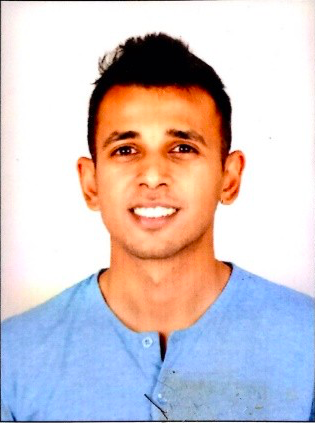
Dipankur Sharma – a player-centric coach who believes in the importance of building connections to ensure players reach their potential both on and off the pitch.
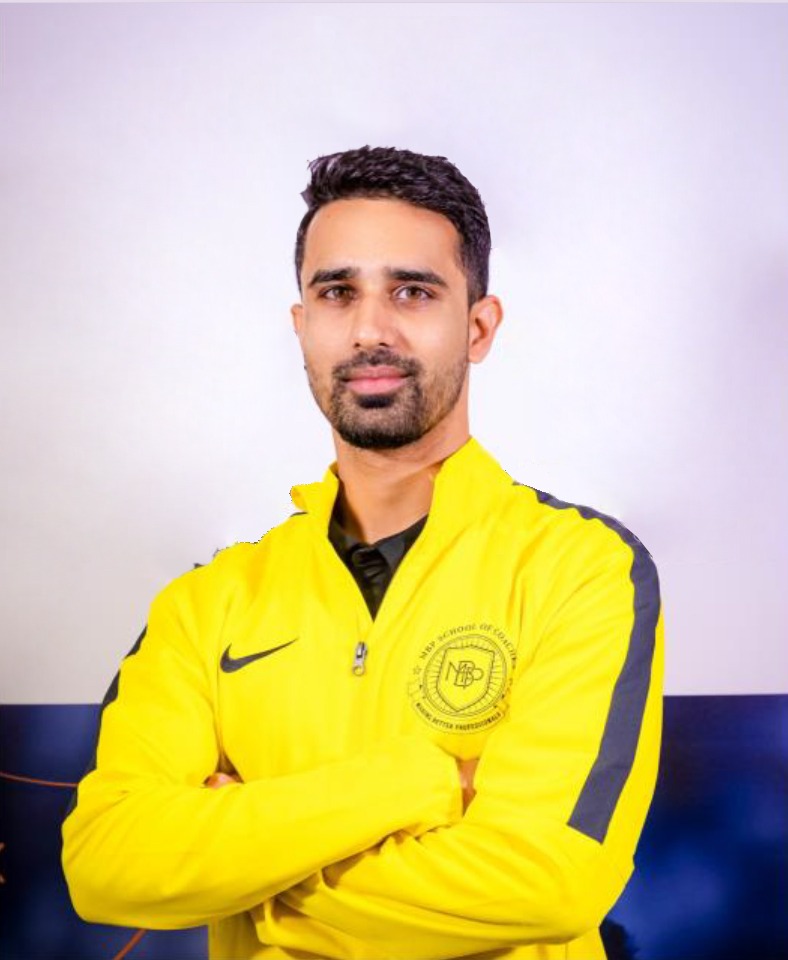

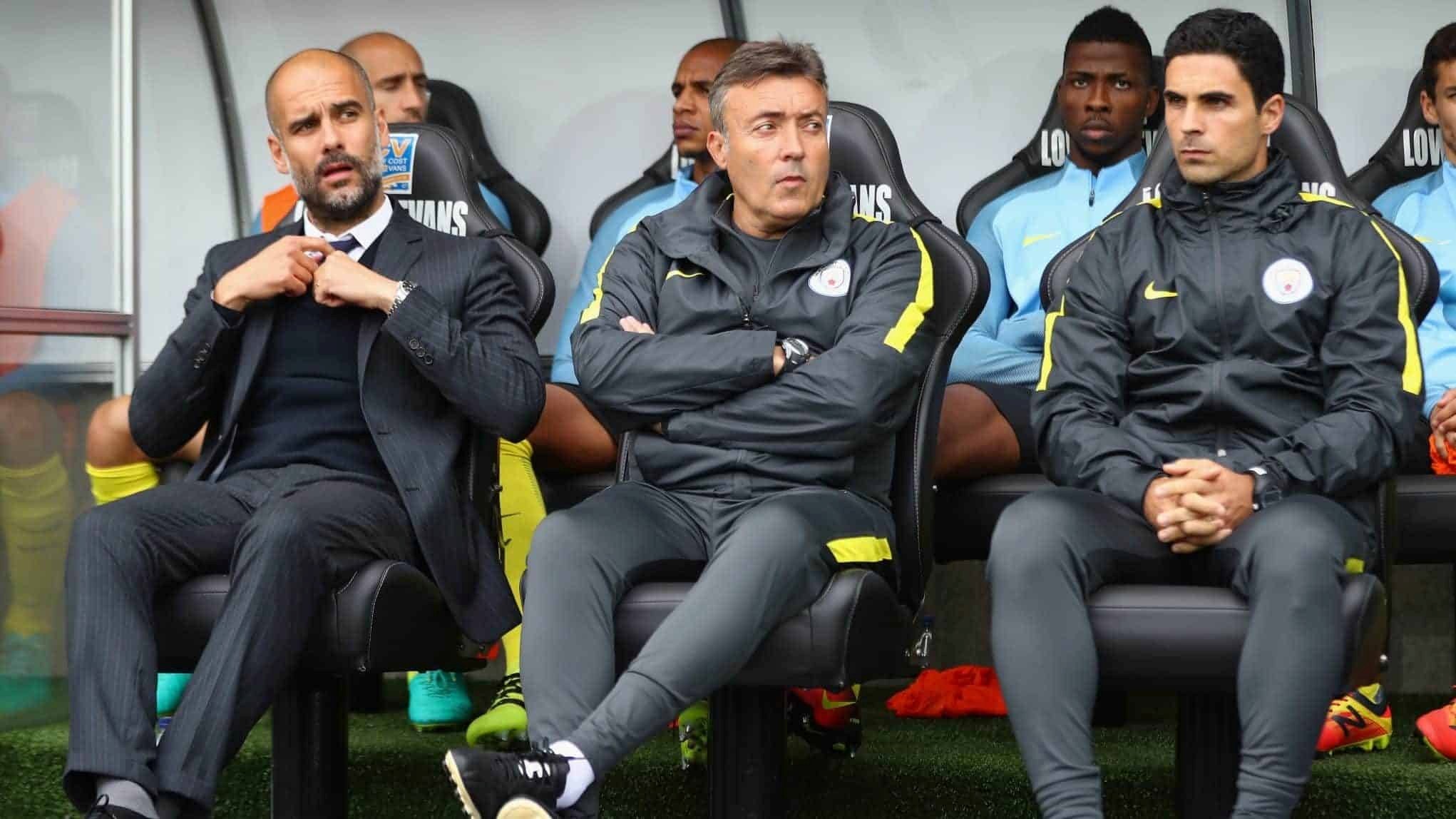
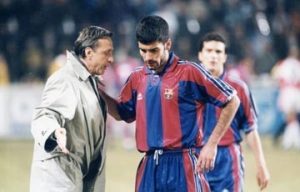


JohnnyRooks
21 Feb 2025Your comment is awaiting moderation.
Казино Вавада это одно из самых модных онлайн-казино, предлагающее игрокам широкий ассортимент игр и привлекательные бонусы. Если вы хотите выяснить, как искать это казино, какие игры в нем доступны и как найти его в Телеграм, то эта статья для вас.
Как искать казино Вавада
Сначала, чтобы попасть в казино Вавада, вы можете воспользоваться последующими способами:
1. Поисковые системы: Просто введите “Казино Вавада” в любой поисковой системе, и вы найдете сайт. Обратите внимание, что веб-сайт возможно заблокирован, в таком случае используйте рабочие зеркала.
2. Рабочие зеркала казино: Если вход на сайт ограничен, отыскивайте животрепещущие рабочие зеркала. Обычно актуальные ссылки можно найти на официальных страницах казино или форумах, посвященных играм на интерес.
3. Социальные сети: Подпишитесь на официальные аккаунты Вавада в социальных сетях вслед за тем часто публикуются новости и ссылки на рабочие зеркала.
Какие забавы в казино Вавада
Казино Вавада делает отличное предложение своим игрокам разнообразие игр на любой вкус:
1. Слоты: Огромное количество автоматов для игры с разными тематиками и бонусными функциями.
2. Настольные игры: Традиционные забавы, такие как рулетка, блэкджек и покер, доступны для тех, кто предпочитает классические казино.
3. Лайв-казино: Забава с живыми дилерами, в каком месте вы можете вести взаимодействие с другими игроками и чувствовать атмосферу настоящего казино.
4. Провайдеры: Казино сотрудничает с знаменитыми производителями игр, что гарантирует высочайшее качество и обилие контента вавада телеграмм канал
Как искать Вавада в Телеграм
Телеграм это хорошая платформа для получения обновлений и информации. Чтобы отыскать казино Вавада в Телеграм, выполните следующие шаги:
1. Поиск по нику: Откройте прибавленье Телеграм и в строке поиска введите “Вавада”. Это поможет найти официальные каналы и группы.
2. Присоединяйтесь к каналам: Найдите и подпишитесь на официальный канал казино Вавада. Вслед за тем вы сможете быть информированными о новых играх, акциях и призах.
3. Общение с участниками: Вступите в чаты и группы игроков, где обсуждаются разные нюансы игры в казино Вавада. Это будет хорошей возможностью поменяться опытом и получить советы.
Казино Вавада предлагает множество возможностей для игры и утехи. Помните о мерах безопасности и играйте трепетно. Фортуны!
JohnnyRooks
22 Feb 2025Your comment is awaiting moderation.
Казино Вавада это одно из самых знаменитых онлайн-казино, предлагающее игрокам большой выбор игр и привлекательные бонусы. Если вы хотите узнать, как найти это казино, какие игры в нем доступны и как найти его в Телеграм, то эта статья вам.
Как искать казино Вавада
Сначала, чтобы попасть в казино Вавада, вы можете воспользоваться следующими способами:
1. Поисковые системы: Просто введите “Казино Вавада” в любой поисковой системе, и вы найдете официальный сайт. Обратите внимание, что веб-сайт может быть заблокирован, в таком случае используйте зеркала.
2. Зеркала казино: Если доступ к сайту ограничен, отыскиваете актуальные рабочие зеркала. Как обычно актуальные ссылки можно отыскать на официальных страничках казино или форумах, посвященных азартным играм.
3. Соц сети: Подпишитесь на официальные аккаунты Вавада в социальных сетях вслед за тем довольно частенько публикуются новости и ссылки на рабочие рабочие зеркала.
Какие игры в казино Вавада
Казино Вавада предлагает своим игрокам разнообразие игр на хоть какой вкус:
1. Игровые слоты: Огромное количество игровых автоматов с разными тематиками и бонусными функциями.
2. Настольные игры: Классические игры, в том числе рулетка, блэкджек и покер, доступны для тех, кто предпочитает традиционные казино.
3. Лайв-казино: Игра с живыми дилерами, где вы можете взаимодействовать с другими игроками и чувствовать атмосферу настоящего казино.
4. Провайдеры: Казино сотрудничает с известными производителями игр, что гарантирует высочайшее качество и разнообразие контента https://telegra.ph/Vavada-telegram-vse-posty-oficialnyj-kanal-02-20
Как найти Вавада в Телеграм
Телеграм это хорошая платформа для получения обновлений и информации. Чтоб отыскать казино Вавада в Телеграм, выполните последующие шаги:
1. Поиск по нику: Откройте прибавленье Телеграм и в строке поиска введите “Вавада”. Это поможет отыскать официальные каналы и группы.
2. Присоединяйтесь к каналам: Найдите и подпишитесь на официальный канал казино Вавада. Там вы сможете быть информированными о новых играх, акциях и бонусах.
3. Общение с участниками: Вступите в чаты и группы игроков, в каком месте обсуждаются разные аспекты игры в казино Вавада. Это будет превосходной возможностью обменяться опытом и получить советы.
Казино Вавада делает отличное предложение огромное количество возможностей для ведения игры и развлечения. Помните о мерах безопасности и играйте трепетно. Фортуны!